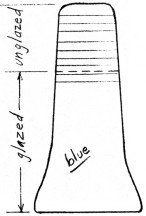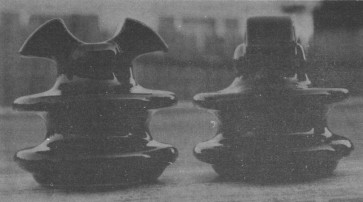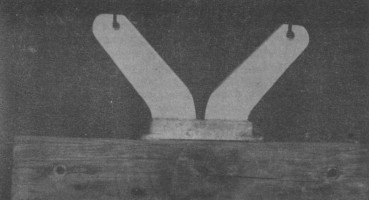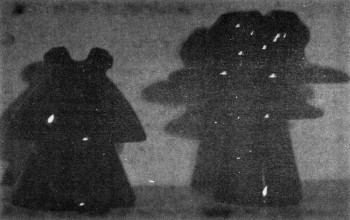Porcelain Insulator News
by Jack H. Tod, NIA #13
Reprinted from "INSULATORS - Crown Jewels of the Wire", April 1983, page 19
Dear Jack:
The enclosed snapshot
is of an insulator I found in an antique store a while back. It caught my eyes
from a distance, since it looked like an insulator. There was no information on
it, just a price tag with the word "insulator". It's about 10"
tall.
I have exhausted my extensive collection of reference material and can
find nothing about it. Is it really an insulator and, if so, have you ever
encountered one like it?
Sue Rugh, NIA #2810
Lynwood, California

- - - - - - - - - -
Dear Sue:
Your
item is part of an insulator, namely the most central portion of a multipart
insulator made by cementing together two or more individual parts. The unglazed
top portion, together with the grooves there, is to afford a good bond with the
cement used to assemble the complete insulators.
This peppery, light blue glaze
is typical of a glaze used by Locke in the 1900-1910 era, and this one company
also made a practice in those years of shipping certain large insulators as
individual porcelain (or glass) parts for final assembly at the construction
site. This undoubtedly accounts for various of these insulator parts turning up
around the country, since it's virtually impossible to separate a multipart into
its mint components once they have been cemented together.
Most of these
insulator parts I've seen in collections or antique stores have been the center
parts such as yours. This could mean they were leftovers due to excessive
defective or broken top shells received for the line construction. Needless to
say, we have many collectors looking for matching top parts, or vice versa, but
the chances for success in that seem pretty remote.
Jack
Dear Jack:
The enclosed
photo is of two brown U-393 insulators my nephew "Mat" found. He gave
me the first one, and needless to say I sent him back to get the other one too!
These were at one time used for two wires from a house to the garage; there were
two common insulators on the garage end. I know of none anywhere else. Other
than the one John Palyo wrote about (April 1980 CJ, page 26), have there been
any others of these reported?

When Mat found out how rare these are, he became
very interested in value. Would you dare to make a guess for him?
I find these
insulators very closely match the original U-393 drawing in your 1971 First
Edition book. What made you revise the drawing in the 1973 Supplement to the
current drawing with the different crown and ears?
Alan Waugh
No. Attleboro,
Mass.
- - - - - - - - -
Dear Alan:
The original U-193 drawing I made in 1971 was from the 1912
Thomas catalog drawing, as was also the U-394 (unknown to date).

Soon
thereafter, we found specimens of the U-393 (and still later, specimens of
U-393A). Even though these specimens were obviously made by Pittsburg, not
Thomas, they looked like the right animal so I revised the drawing to fit the
specimens. These specimens had all the definitive Pittsburg characteristics --
the unglazed square-topped pin hole and the overall mold line from having been
formed in a parting-type forming mold (no later groove trimming required).
But
your specimens are just like the Thomas drawing with those rounded ears, and
your photo clearly shows the insulator was made in the customary one-piece press
forming mold and the side grooves added by trimming.
Just to go back 12 years
and re-correct the matter, I'm assigning the number U-392 to the Thomas item
with the rounded ears. We'll retain the U-393 number which is established for
the flat-ear specimens.
I think I had one other report of a brown U-392 besides
the one Palyo reported in 1977 and 1980, and I didn't catch his insulator as
being different from U-393 until just now when you pointed it out. I think the
broken brown one Jerry Turner found in the old Pittsburg plant dumpage in 1973
was a U-393 (flat eared). But just for kicks, look at the U-392 being held in
the photo at top of page 15 in Jan 1983 CJ!
I'm not very good at guessing values
of rare insulators such as the U-392. To be conservative, I'd say "at least
$50", but my gut feeling is "$100 and up". Would be interesting
to see the final bid if one of these ever got into a face-to-face auction among
several active and eager collectors.
Jack
There is still one unanswered question
on the U-393. At one time I had a number of white U-393, but I now have only a
single specimen obviously made by Pittsburg. I seem to recall having noticed
back then that those I had all generally agreed with the U-393 (flat eared), but
that most of them appeared more like Thomas manufacture instead of Pittsburg --
having a quality white glaze, no forming mold line, a glazed pin hole with a
rounded top, etc.
In an effort to complete the picture on these insulators, I
would very much like to receive information from collectors who have any
specimens of U-392 or U-393. Just the bare info on a postcard would be great. I
could not personally acknowledge all the cards, but a summary of all the info
plus a credit to all those reporting will appear in CJ later. The information we
need on each specimen is:
A. Style (U-392 or U-393), and color (white or brown)
B. Construction: Overall mold line (as on Pittsburg), or side grooves made by
trimming (as on Thomas)
C. Pin hole: Unglazed with flat or ringed top (as done
by Pittsburg), or glazed with rounded top (Thomas)
Send this information to Jack
H. Tod, 3427 N. 47th Place, Phoenix, AZ 85018. And many thanks in advance for
same!

Regarding the recent corporate changes in the insulator plant at Victor,
New York (see January 1983 CJ, page 31), we have received from the plant a
detailed account of this, together with inkpad impressions of several of the
marking devices now in use, two of which are shown above. The company's letter
is paraphrased below. Also, see the following letter from Joe Maurath, Jr.
The
1976 merger of I-T-E Imperial and Gould Inc. continued until 1980. At that time,
Gould Inc. entered into a joint venture with Brown Boveri of Baden, Switzerland,
whereby essentially all former I-T-E Imperial Divisions incorporated into Gould
Inc. were reorganized into the joint venture.
This new company was identified as
Gould-Brown Boveri. Throughout the period of the joint venture, insulator
markings continued to be identical to those in use under Gould Inc., namely the
Gould "logo".
However, in late 1981, Gould Inc. sold its interest in
the joint venture to Brown Boveri, and the former I-T-E Imperial Divisions
became Brown Boveri, Electric, Inc., a wholly owned subsidiary of Brown Boveri.
At that time, insulator markings were changed from the Gould "logo" to
a stamp simply identifying the manufacturer as "BBC". The stamp on
low voltage pin type insulators continues to be an incuse stamp.
When we get a
reply to our inquiry about the meaning of the letter "C" in
"BBC", we'll let you know about it.
Jack

Dear Jack:
The linemen where
I work occasionally bring in some old insulators that interest me, but there are
some much newer insulators in our stock which night be of interest to you and
your readers.
These are U-735A, sky glaze with shiny black radio-noise-free
crown, and they have an incuse handstamp "BBC" marking like the foil
impression I have enclosed. The shipping cartons indicate they were made by
Brown Boveri Electric, Inc., Insulator Division, Victor, NY, and I believe Brown
Boveri purchased some of the I-T-E Imperial company divisions including the
insulator plant at Victor. Do you have any information on this?
Is the
"F" under the BBC identification some sort of factory code?
Are you
going to resume your porcelain column in Crown Jewels? Your past columns,
together with the informative books you've published help me to identify some of
the unusual pieces that are brought in here.
Joe Maurath, Jr.
Abington, Mass.
- - - - - - - - -
(Note: See material preceding Joe Maurath's letter for info regarding Brown
Boveri Electric and the BBC marking.)
Dear Joe:
Many thanks for report of this
new marking now in use.
The "F" under the company identifier
undoubtedly indicates the insulator has the "F neck" dimensions for accommodating
preformed tie wires. The dimensional differences of these various crowns are so
subtle that it helps to have a positive identification of them on the insulator
to avoid confusion in stocking them and use in the field.
Jack
In the January
1983 issue we reran the report of George Hanson (Montana) on the unusual insulator
found in Alaska, a portion of the column copy lost in the mail last summer. We
now have a replacement for the lost photo of that item. Note that the insulator
is mounted in the middle of a stubby 24" crossarm.
Jack

Dear Jack:
I am a
senior electrical engineering student at Michigan Tech, and I spend most of my
spare time hunting insulators in the copper country, which is almost abandoned
of any industry now. About a year ago I backpacked out about eight of the U-966
"Niagara Style" insulator (left in photo below). I was very fortunate
to get these and I had to work to get them.

I think these might be New
Lexingtons. All are very crudely made glazewelds with glazes running from a
mustard brown to reddish-browns, and have a very large pin hole.
But a solitary
one of these is a cemented two-piece with a high quality jet black glaze, and it
is marked THOMAS on the underside of the base. The other crude ones were obviously made by a different company or a different time period. I have seen
over 50 broken ones of the crude type on the ground but none of the ones like
the Thomas one.
Can you tell me how rare this Thomas one is, and its rarity
relative to the other types, and also some indication of their values? Also, do
you know of other places where any of these old U-966 insulators have been
found?
The other insulator (at right in the photo) is stamped THOMAS, has a jet
black glaze and is cemented multipart. This one used to have a cemented-in pin
which turned into a pipe with pipe threads, and they were used on a tri-part
steel tower which used to have crossarms of pipe. I had seen a picture in the
archives of a town where this line ran through. The picture was dated 1897, and
it showed the line having large white multiparts (yum-yum!). This line was
reinsulated many times and now sports wooden crossarms. The original line was 12
miles long and supplied a smelting operation (which is now rubble), and only two
miles of the line remain. Many different insulators (mostly broken) of various
styles have been found along the old route.
Ken Stefan
Hancock, Michigan
- - - - - - - - - - -
Dear
Ken:
The U-966 is a very interesting insulator and is unique for its unusual
styling and the 1-5/8" pinhole size. Being a westerner, I'm not very
familiar with these -- where they have been found, the markings on them,
glazewelds versus cemented ones, ways to attribute them to company, etc.
The one
thing I am sure of is that collectors have gradually started to class these
large, very old insulators as the real goodies. Many of the more advanced
collectors are probably now cleaning house of endless rows of the small, modern
pin types saved just because they were different in some small way, all to make
room for a lesser number of really unusual and rare antiques.
Many of the small
styles of old insulators are still around because they are still serviceable for
some lines, especially with small utility companies. But this is not true of
these old transmission line insulators. The very few that ever do surface were
the result of a lot of research and backpacking into remote country such as you
have done, or by plain luck in stumbling onto the right old dump.
I am no longer
active enough in collecting or attending shows to make even reasonable guesses
as to value on these old specimens, but I think it might be considerable. Most
collectors would recognize their rarity and would reward the owner for the hard
work it took to find and rescue them.
Jack

Robert Winkler (Indiana), our artist
for the "Porcelain Corner" drawings, poses an interesting theory for
the letter "B" that accompanies the 1922-1928 marking on some Locke
insulators. He theorizes that this could have been a factory reference for
insulators being made at G.E.'s Baltimore plant, inasmuch as they also continued
producing insulators at the old plant at Victor, N.Y. until shutting that plant
down in 1928.
This sounds very logical to me. If anyone has specimens with the
1922-1928 marking bearing letters other than B, or if there are specimens of the
pre-1922 marking with similar letter coding, that would shoot down our balloon.
If a 40 year old Locke man did this coding in 1922, he'd be 101 years old now.
Guess we'll never be able to confirm the theory.
| 